Sheet Pan Lemon Pepper Salmon with Veggies
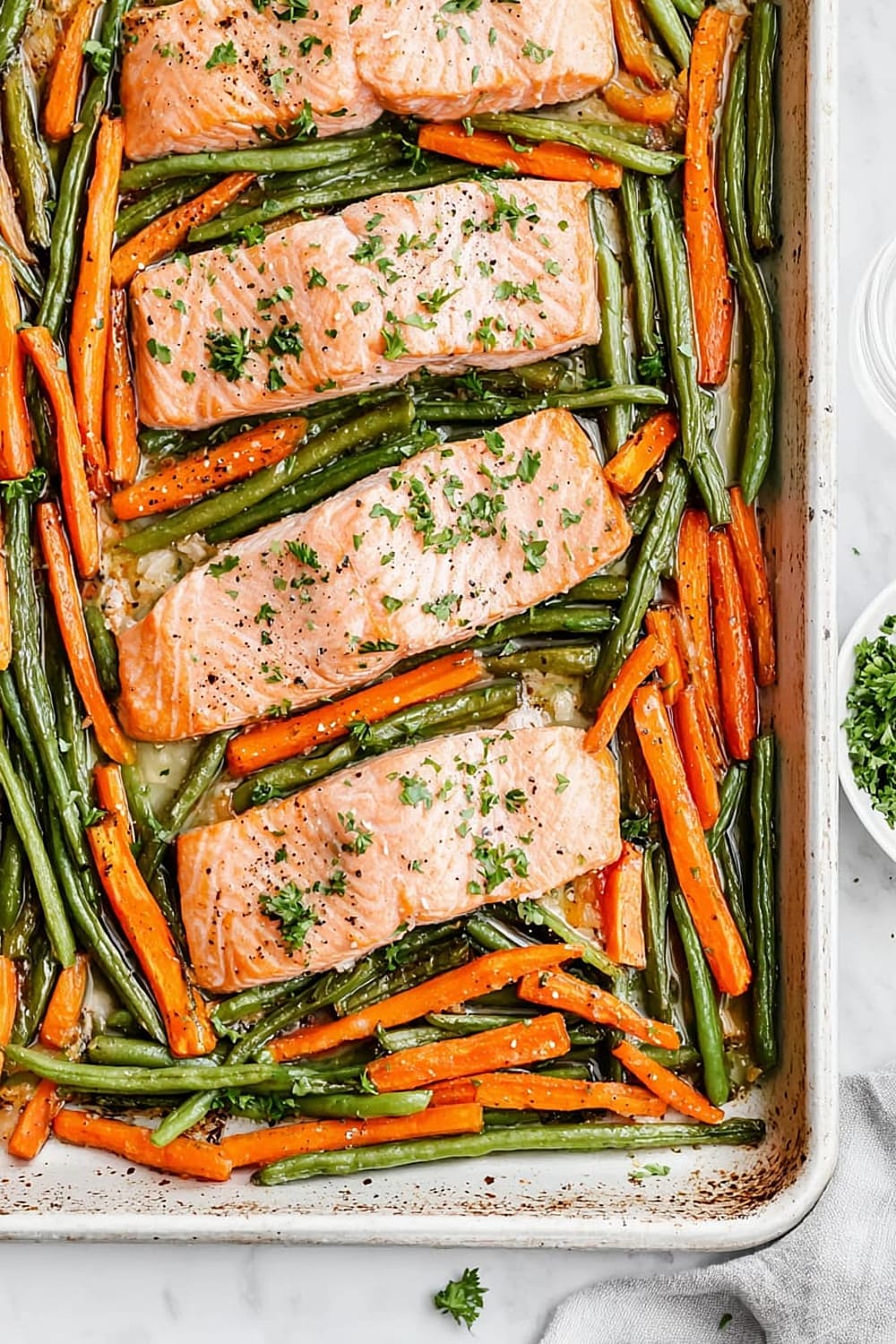
This is the kind of recipe that makes you look like a meal-planning genius while secretly requiring zero advanced cooking skills.
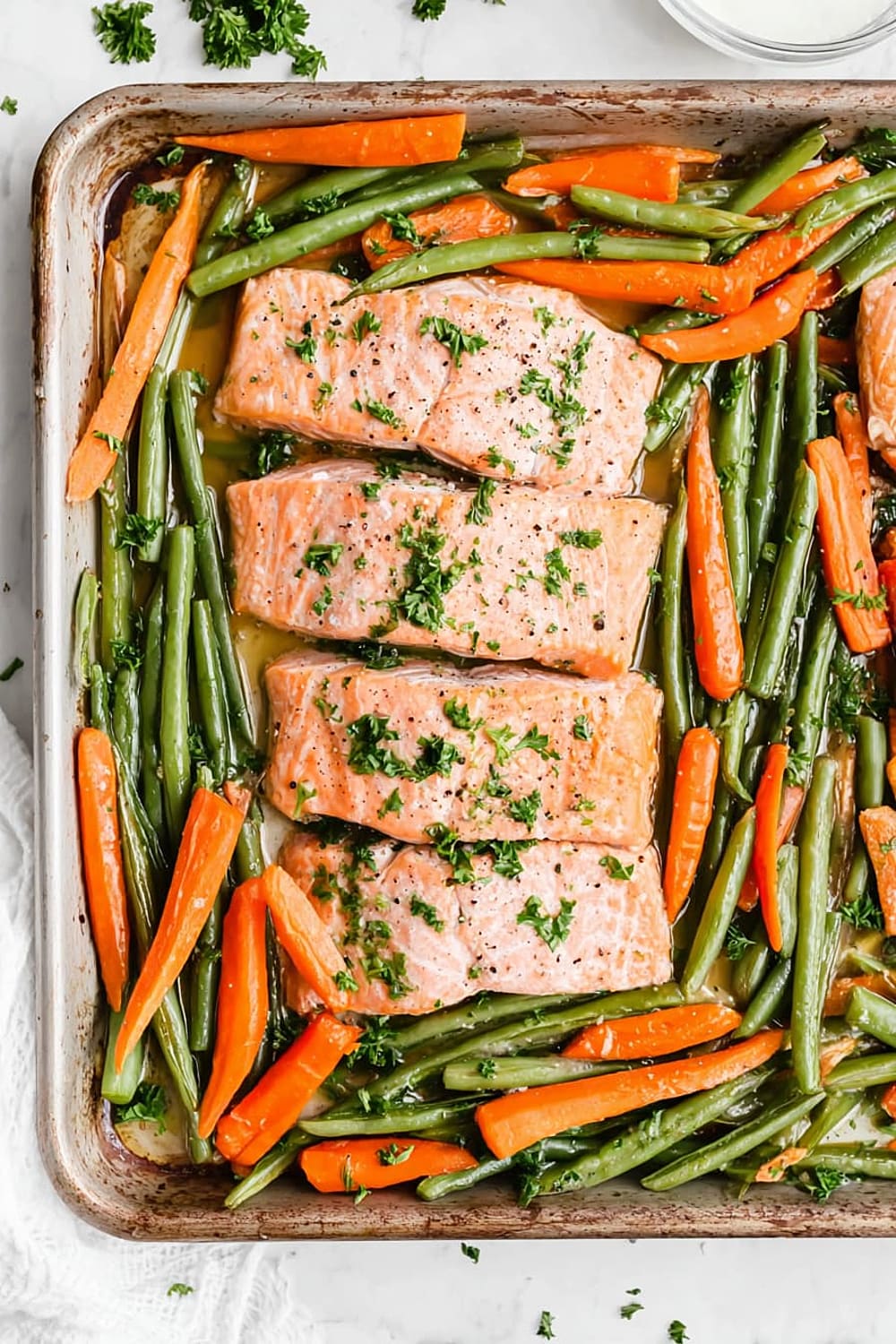
Picture perfectly flaky salmon with a bright lemon-pepper crust alongside tender-crisp vegetables that actually taste like something, not like sad cafeteria leftovers.
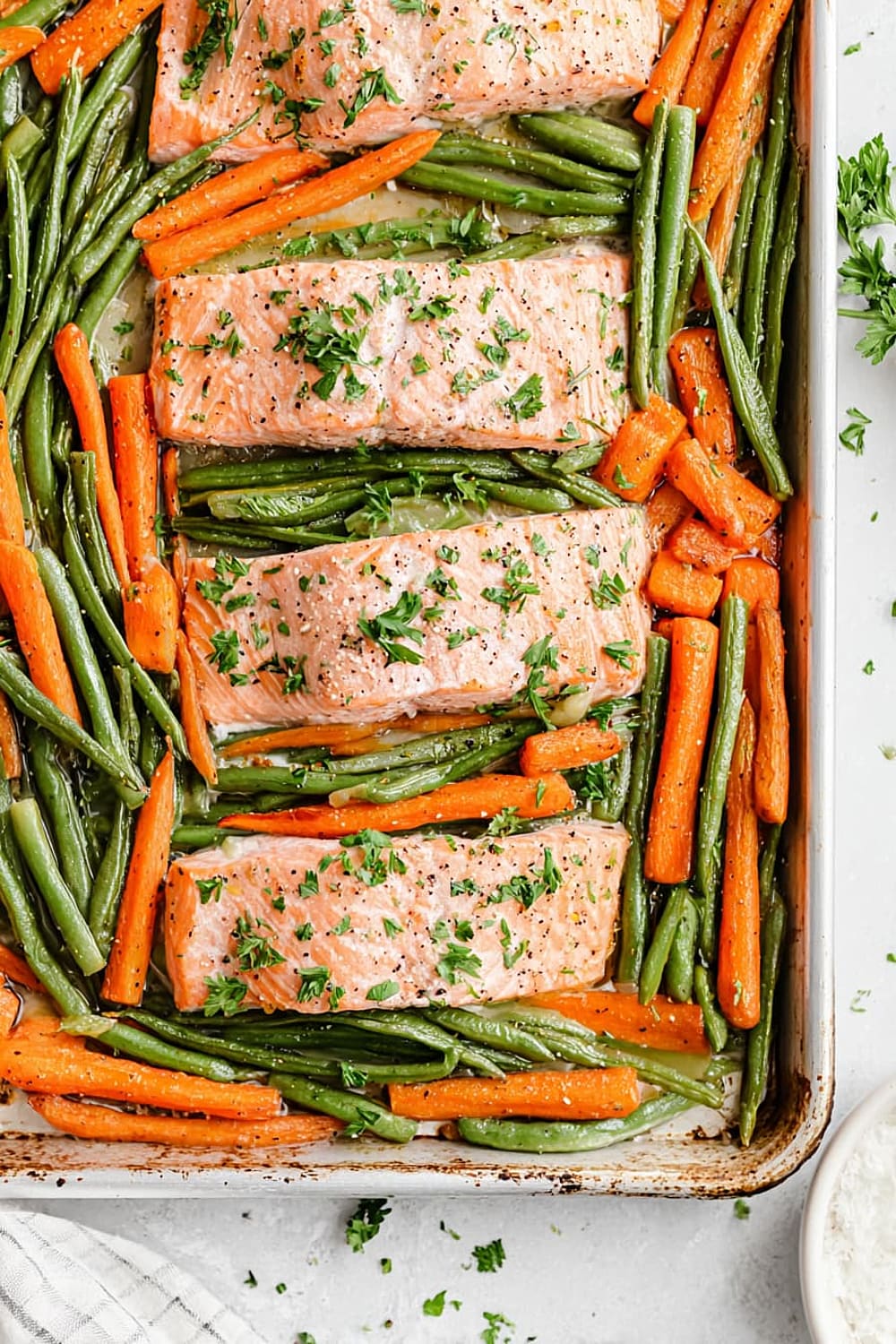
The magic happens when everything roasts together on one sheet pan, creating those beautiful caramelized edges while the lemon juice works its citrusy charm on both the fish and veggies.
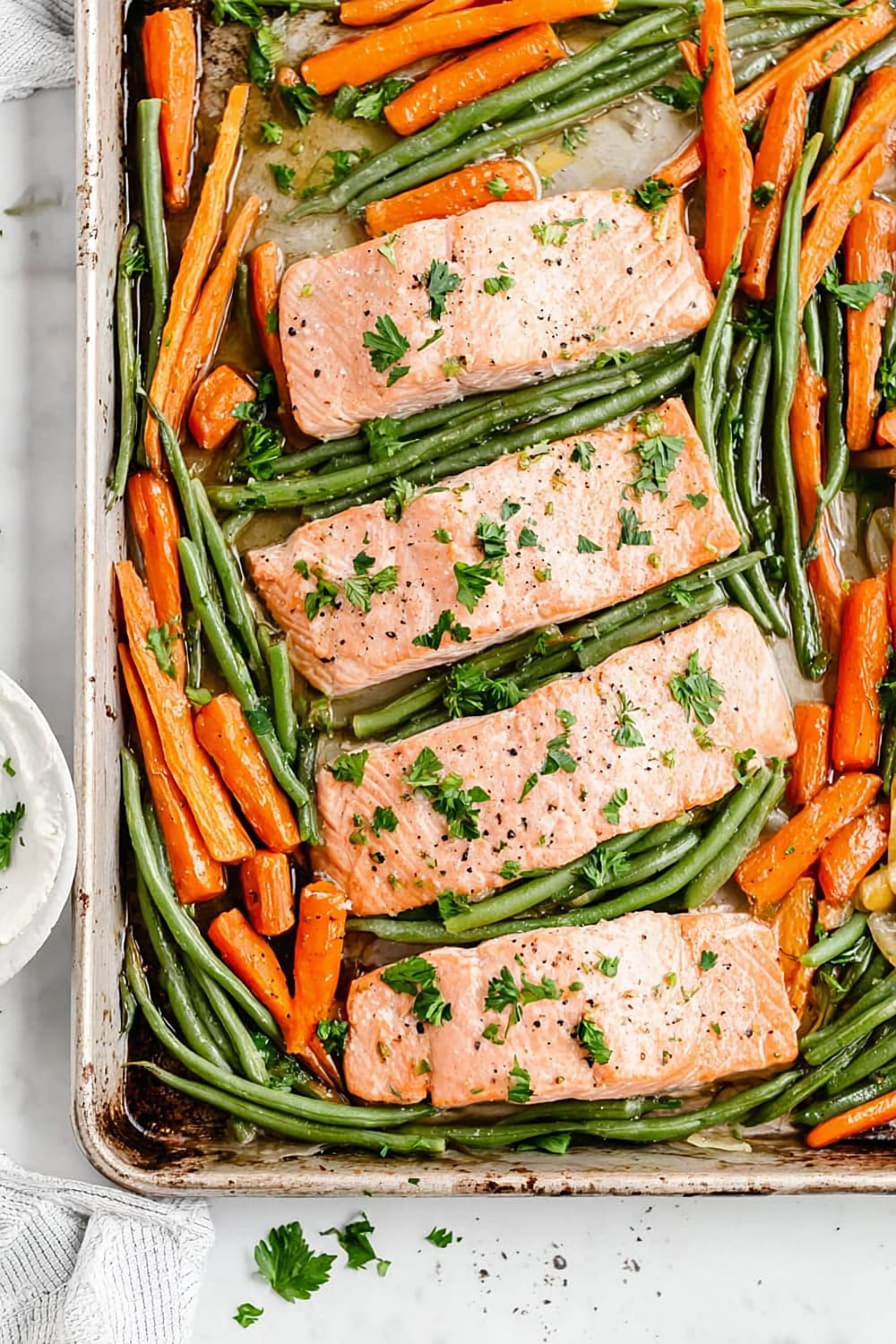
You’ll have dinner on the table in about 30 minutes, with minimal cleanup and maximum “wow, you actually cooked this?” factor.
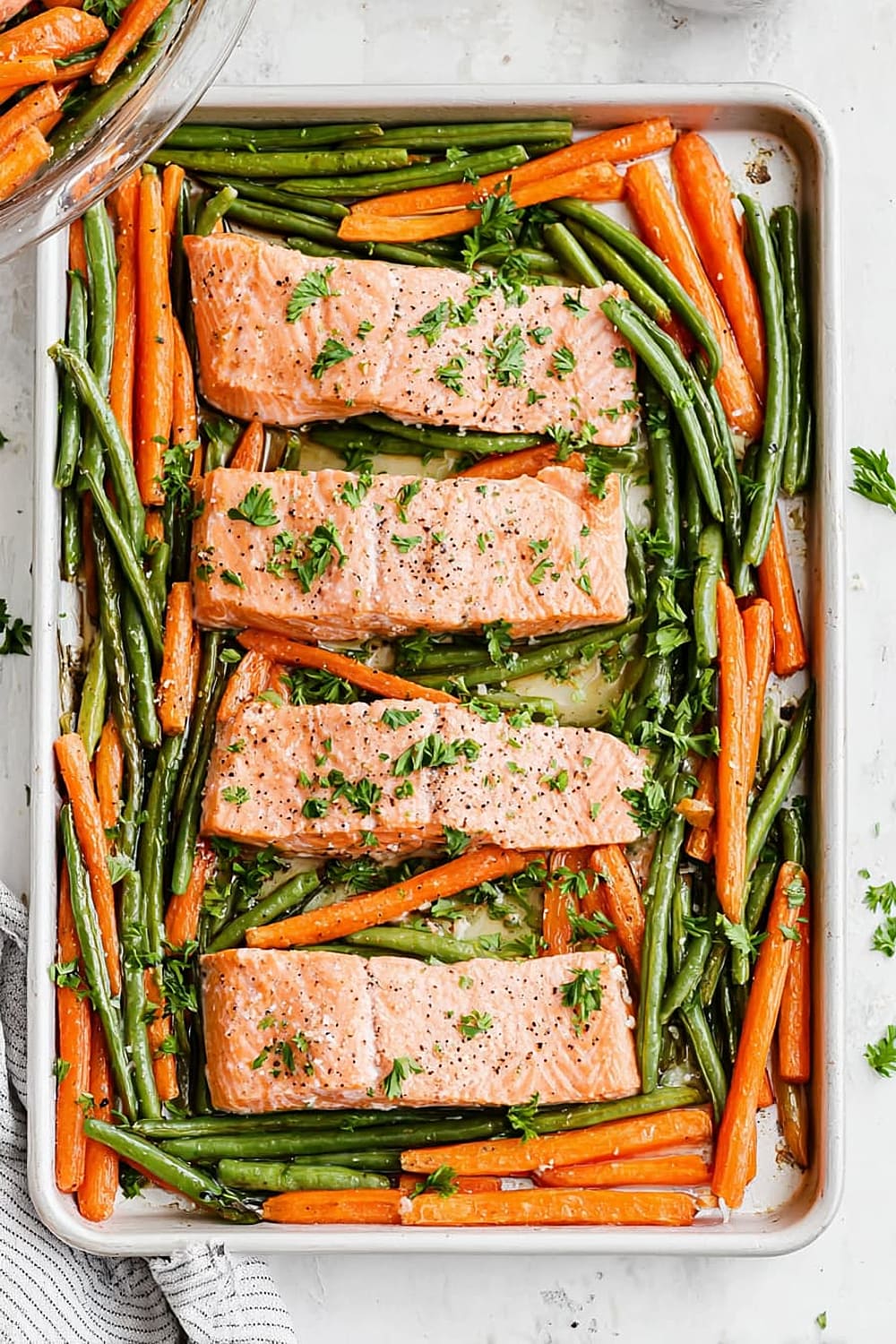
The combination of garlic powder, fresh lemon juice, and cracked black pepper creates this incredibly aromatic coating that makes your kitchen smell like a fancy restaurant.
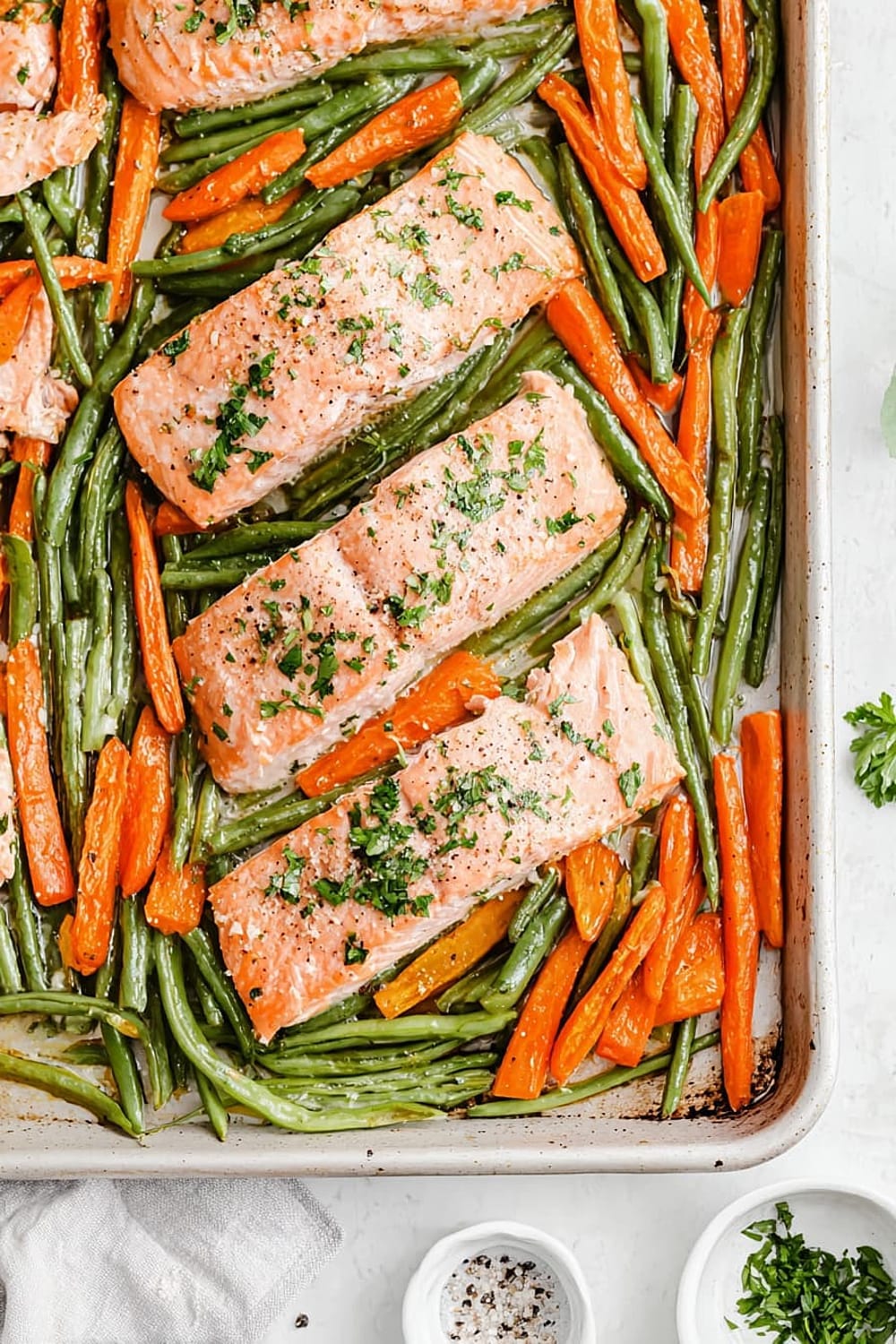
Plus, it’s basically a complete meal disguised as effortless weeknight cooking – protein, vegetables, and enough flavor to make everyone forget they’re eating something healthy.
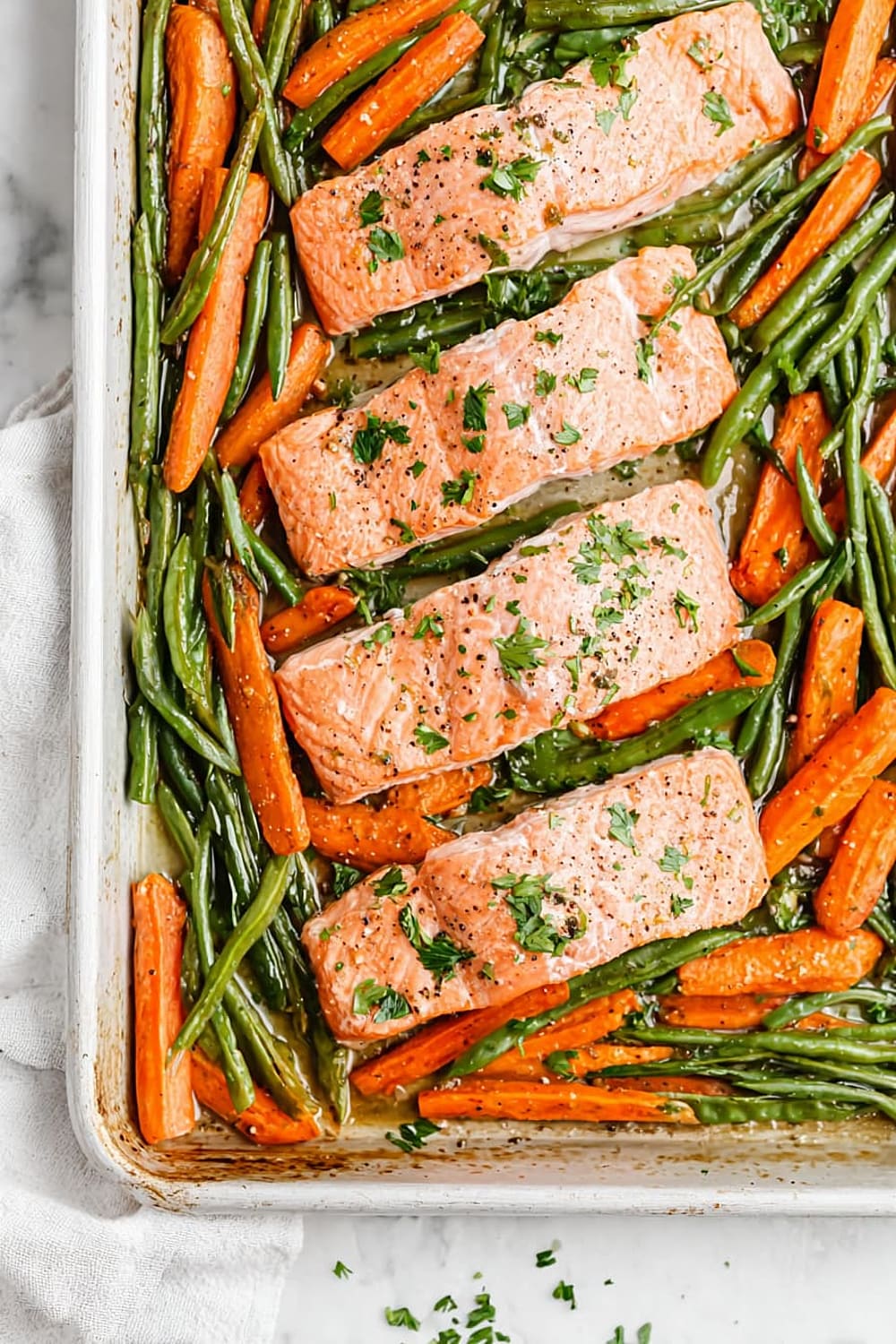
Ingredients
For the Vegetables
- 12 ounces fresh green beans, halved
- 1 pound carrots, peeled and cut into sticks
- 1 tablespoon extra virgin olive oil (from total amount)
- 2 tablespoons fresh lemon juice (from total amount)
- ½ teaspoon garlic powder
- ½ teaspoon salt
For the Salmon
- 4 6-ounce salmon fillets
- 1 tablespoon extra virgin olive oil (remaining from total)
- 2 tablespoons fresh lemon juice (remaining from total)
- ½ teaspoon salt
- ¾ teaspoon black pepper
- 1-2 tablespoons fresh parsley, chopped for garnish
Instructions
Preparation
- 1 Preheat your oven to 425°F (220°C) and line a large sheet pan with parchment paper. Using parchment paper prevents sticking and makes cleanup incredibly easy, plus it helps achieve those perfect caramelized edges without burning.
- 2 Prepare your vegetables by cutting the green beans in half and slicing the carrots into uniform sticks about ½-inch thick. Consistent sizing ensures even cooking – nobody wants crunchy carrots next to mushy green beans.
First Roasting Phase
- 3 Arrange the carrot sticks and green beans on the parchment paper lined baking sheet in a single layer. You can keep them separated by type or mix them together – both approaches work perfectly and cook evenly.
- 4 Sprinkle ½ teaspoon salt over the vegetables. In a small mixing bowl, whisk together 2 tablespoons olive oil, 2 tablespoons lemon juice, and ½ teaspoon garlic powder until well combined. Reserve the remaining 2 tablespoons lemon juice for the salmon – this is crucial for proper seasoning balance.
- 5 Drizzle the oil and lemon mixture evenly over the vegetables, then toss with tongs or your hands to ensure every piece is coated. Roast for 12 minutes until the vegetables start to soften and develop light golden edges.
Adding the Salmon
- 6 Remove the baking sheet from the oven (leave the oven on) and gently stir or flip the vegetables with a spatula. Push the vegetables to create space for the salmon fillets, ensuring they won’t overlap.
- 7 Place the salmon fillets skin-side down on the sheet pan, nestling them among the partially cooked vegetables. The skin acts as a natural barrier, preventing the fish from sticking and overcooking.
- 8 Squeeze the remaining 2 tablespoons fresh lemon juice directly over each salmon fillet, then season with the remaining ½ teaspoon salt and ¾ teaspoon black pepper. The lemon juice will create a beautiful glaze as it bakes.
Final Cooking
- 9 Reduce the oven temperature to 400°F (200°C) – this lower temperature prevents the salmon from overcooking while allowing the vegetables to finish perfectly. Return the sheet pan to the oven and bake for 12-15 minutes.
- 10 Check for doneness by gently pressing the thickest part of the salmon – it should flake easily and have an internal temperature of 145°F (63°C). The vegetables should be tender-crisp with beautiful caramelized edges.
- 11 Remove from the oven and immediately sprinkle the chopped fresh parsley over the salmon fillets. Let rest for 2-3 minutes before serving to allow the juices to redistribute.
Recommended Equipment and Kitchen Tools
Essential Tools (for best results)
- Large sheet pan (12×17 inches recommended) – provides adequate space without overcrowding, ensuring proper browning and even cooking
- Parchment paper – prevents sticking and makes cleanup effortless while promoting even browning
- Small mixing bowls – perfect for whisking the oil, lemon juice, and seasonings together
- Instant-read thermometer – takes the guesswork out of perfectly cooked salmon every time
Helpful Upgrades
- Kitchen scale – ensures precise measurements for consistent results, especially helpful for portioning salmon fillets
- Microplane grater – if you want to add fresh lemon zest for extra citrus punch
- Silicone spatula – ideal for gently tossing vegetables without scratching your sheet pan
- Quality tongs – makes flipping and arranging vegetables much easier than using forks
Nice-to-Have Options
- Cast iron sheet pan – retains heat beautifully and creates superior caramelization, though any heavy-duty sheet pan works well
- Bench scraper – helpful for efficiently transferring chopped vegetables from cutting board to pan
- Digital scale – professional-level precision for ingredient measurements, especially useful for meal prep batches
Recipe Variations and Dietary Modifications
Vegetable Variations
- Seasonal swaps: Replace green beans with asparagus, Brussels sprouts, or broccoli florets
- Root vegetable medley: Add parsnips, sweet potatoes, or baby potatoes (increase initial cooking time by 5 minutes)
- Mediterranean twist: Include cherry tomatoes, zucchini, and red bell peppers for different flavor profiles
- Winter vegetables: Try butternut squash, cauliflower, and red onion wedges
Protein Alternatives
- White fish substitution: Use cod, halibut, or sea bass with the same cooking method and timing
- Chicken adaptation: Replace with boneless chicken thighs, increase cooking time to 20-25 minutes total
- Plant-based option: Substitute with firm tofu or tempeh, reducing final cooking time to 8-10 minutes
Flavor Profile Changes
- Herb-crusted version: Add dried oregano, thyme, and rosemary to the seasoning blend
- Spicy kick: Include red pepper flakes or paprika in the vegetable seasoning
- Asian-inspired: Replace lemon with lime juice and add fresh ginger and soy sauce
- Garlic lovers: Use fresh minced garlic instead of powder, adding it in the last 5 minutes to prevent burning
Nutritional Information and Health Benefits
Key Nutritional Highlights
Each serving provides approximately 350-400 calories with an excellent macronutrient balance of 35-40g high-quality protein from the salmon, 15g healthy fats from the olive oil and fish, and 12-15g complex carbohydrates from the vegetables. The dish is naturally rich in omega-3 fatty acids, providing about 1.5g per serving, which supports heart and brain health.
Health Benefits of Main Ingredients
Salmon delivers exceptional amounts of omega-3 fatty acids EPA and DHA, which reduce inflammation and support cardiovascular health. It’s also packed with vitamin D, B vitamins, and selenium. Carrots provide beta-carotene (converted to vitamin A), supporting eye health and immune function, while green beans contribute vitamin K, folate, and fiber for bone health and digestive wellness. The extra virgin olive oil adds monounsaturated fats and antioxidants that enhance nutrient absorption from the vegetables.
Dietary Considerations
This recipe is naturally gluten-free, dairy-free, and keto-friendly with only 8-10g net carbs per serving. It’s suitable for paleo, Whole30, and Mediterranean diet approaches. The high protein content makes it excellent for muscle maintenance and weight management, while the fiber from vegetables promotes satiety and digestive health.
Smart Swaps and Ingredient Substitutions
Oil and Fat Substitutions:
- Extra virgin olive oil → Avocado oil or melted grass-fed butter (same measurements)
- Lower fat option → Reduce oil to 1 tablespoon total and use cooking spray on vegetables
- Flavor enhancement → Add 1 teaspoon of the oil as finishing oil after cooking for more pronounced flavor
Citrus Alternatives:
- Fresh lemon juice → Fresh lime juice or orange juice for different citrus profiles
- Bottled lemon juice → Use if fresh isn’t available, but reduce amount by 1 tablespoon as it’s more concentrated
- Citrus zest addition → Add 1 teaspoon lemon zest for more intense citrus flavor without extra liquid
Seasoning Modifications:
- Garlic powder → 2-3 cloves fresh minced garlic (add in final 5 minutes to prevent burning)
- Black pepper → White pepper or lemon pepper seasoning for variation
- Fresh parsley → Fresh dill, chives, or cilantro based on flavor preferences
Budget-Friendly Swaps:
- Wild-caught salmon → Farm-raised salmon or frozen salmon fillets (thaw completely first)
- Organic vegetables → Conventional produce works perfectly with the same cooking method
- Fresh herbs → 1 teaspoon dried parsley or Italian seasoning blend
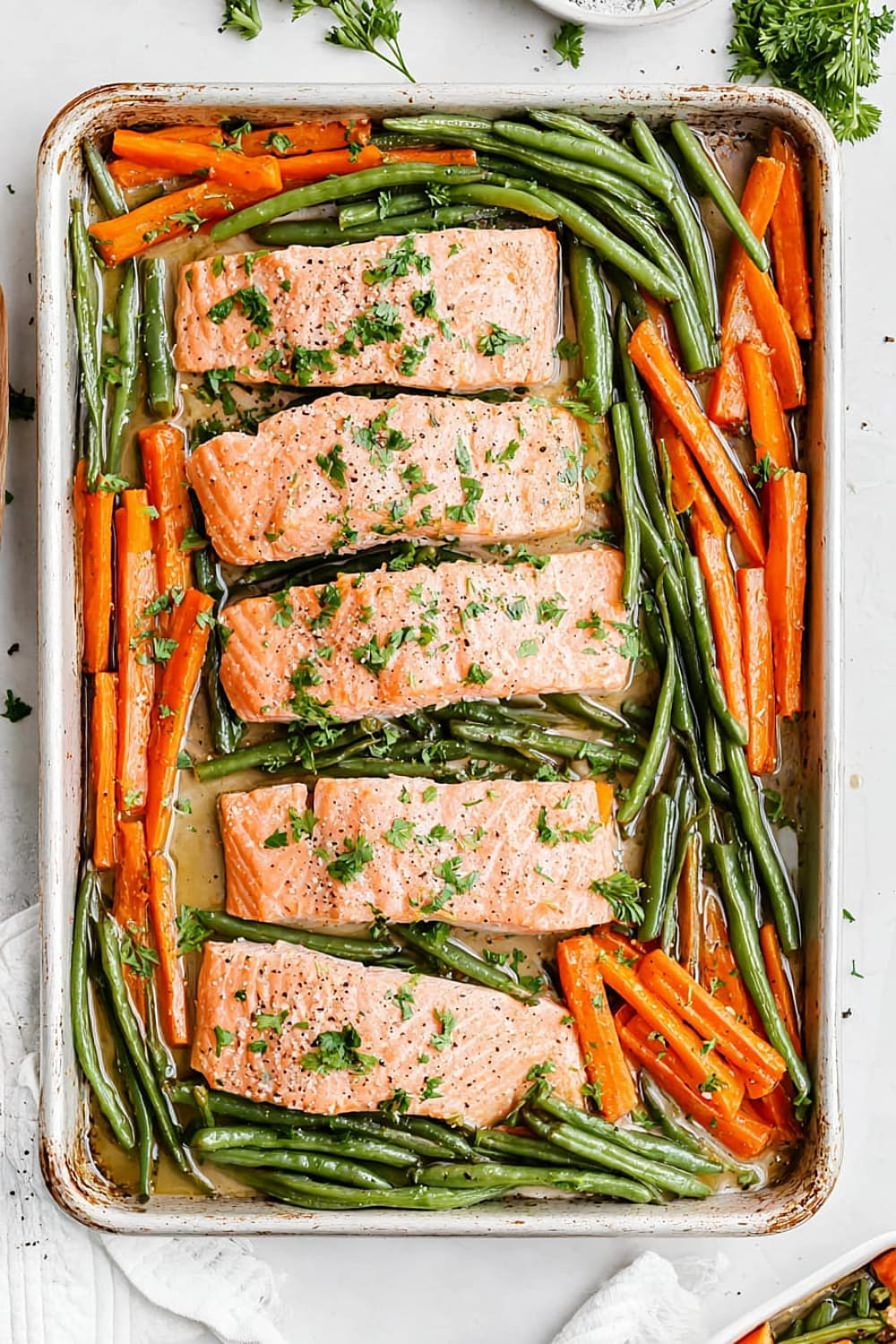
Make It Diabetes-Friendly
Carbohydrate Content:
- Total carbs per serving: Approximately 12-15g with 3-4g fiber, resulting in 8-11g net carbs
- Glycemic impact: Very low due to high fiber vegetables and protein-rich salmon
- Blood sugar benefits: The combination of protein and healthy fats helps stabilize glucose response
Portion Control Strategies:
- Recommended serving: One 6-ounce salmon fillet with 1 cup mixed vegetables
- Carb distribution: Carrots contribute 6-8g carbs, green beans add 4-5g carbs per serving
- Meal timing: Ideal for lunch or dinner when paired with a small side salad
Enhancement Options:
- Add healthy fats: Include ¼ avocado or 1 tablespoon chopped nuts to further slow carb absorption
- Fiber boost: Serve over cauliflower rice or zucchini noodles instead of grains
- Protein increase: Add 2 tablespoons pumpkin seeds or hemp hearts for extra protein and minerals
Blood Sugar Management:
- Pre-meal preparation: The high protein content helps prevent blood sugar spikes
- Post-meal benefits: Omega-3 fatty acids support insulin sensitivity
- Meal pairing: Combine with leafy greens or cucumber salad for additional fiber without significant carbs
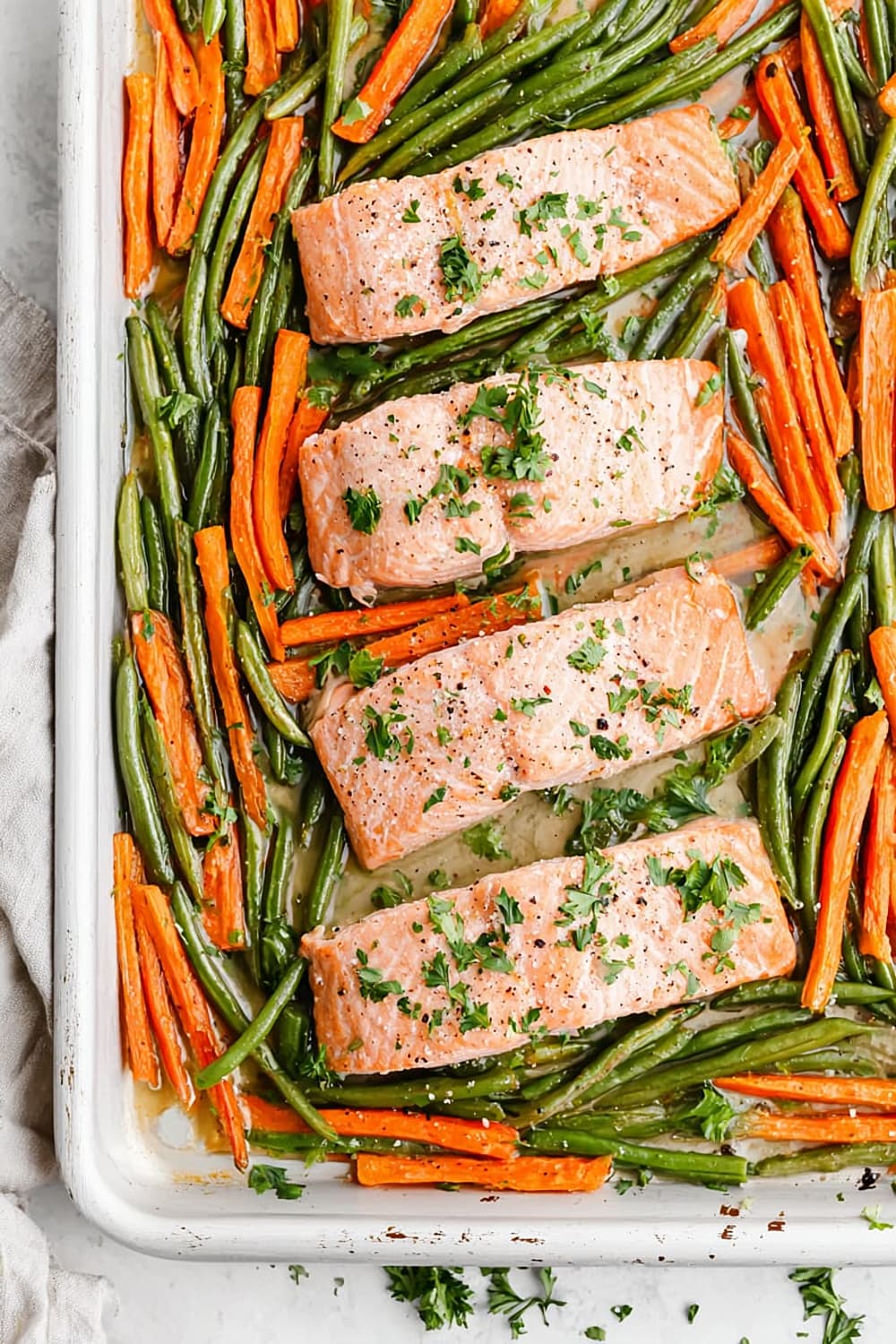
Perfect Pairing Suggestions
Beverage Pairings
A crisp Sauvignon Blanc or Pinot Grigio complements the lemon-pepper flavors beautifully, while Chardonnay pairs well with the richness of the salmon. For beer lovers, a wheat beer or light lager won’t compete with the delicate fish flavors. Sparkling water with lemon or unsweetened iced tea provide refreshing non-alcoholic options that cleanse the palate between bites.
Side Dish Recommendations
Wild rice pilaf or quinoa adds substance while complementing the earthy vegetable flavors. A mixed greens salad with cucumber and cherry tomatoes provides refreshing contrast to the warm, roasted elements. Garlic bread or dinner rolls work for heartier appetites, while roasted sweet potato wedges add natural sweetness that pairs beautifully with the lemon-pepper seasoning.
Complete Meal Ideas
Start with a spinach and strawberry salad to complement the salmon’s richness, then follow with this sheet pan dinner. For entertaining, serve herb-crusted bread alongside and finish with lemon sorbet or berry parfait. The meal works perfectly for Sunday family dinners, date nights, or casual entertaining when you want something impressive but manageable.
Seasonal Adaptations
Spring: Pair with asparagus soup and fresh berries. Summer: Serve with gazpacho and grilled corn. Fall: Add butternut squash soup and apple crisp. Winter: Complement with roasted root vegetable medley and citrus salad.
Pro Tips and Troubleshooting
Professional Techniques
Pat salmon completely dry before seasoning – moisture prevents proper browning and creates steam instead of the desired caramelized surface. Room temperature fish cooks more evenly, so remove salmon from refrigerator 15-20 minutes before cooking. Score the skin lightly if keeping it on to prevent curling and ensure flat contact with the pan.
Common Mistake Prevention
Overcrowding kills browning – use two sheet pans if necessary rather than cramming everything onto one. Don’t flip salmon during cooking unless it’s sticking badly; the skin-side-down method creates perfect texture. Vegetable size matters – cut pieces uniformly so everything finishes cooking simultaneously.
Storage and Reheating
Refrigerate leftovers for up to 3 days in airtight containers. Reheat gently in a 300°F (150°C) oven for 8-10 minutes to prevent overcooking the salmon. Microwave reheating works for vegetables but can make salmon rubbery – use 50% power for 1-2 minutes maximum.
Make-Ahead Strategies
Prep vegetables up to 24 hours ahead, storing them seasoned in the refrigerator. Season salmon up to 4 hours before cooking for deeper flavor penetration. Complete sheet pans can be assembled 2-3 hours ahead and refrigerated, then baked directly from cold (add 3-5 extra minutes to cooking time).
Scaling and Presentation
Double the recipe using two sheet pans for larger gatherings. Individual presentation: Serve each fillet on a warmed plate with vegetables arranged alongside and a lemon wedge garnish. Family style: Present the entire sheet pan as a rustic, impressive centerpiece.
This sheet pan lemon pepper salmon with vegetables proves that weeknight dinners don’t have to be boring or complicated – just delicious, nutritious, and satisfying enough to make everyone happy to be sitting around your table.